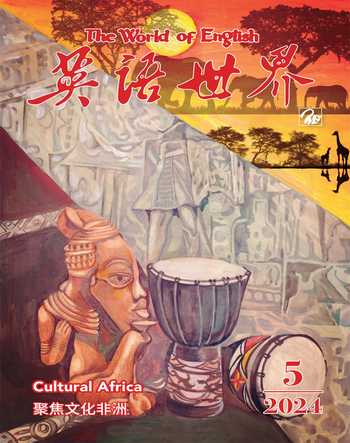Amazing African Tribal Traditions奇妙的非洲部落传统
莱斯利·马钱特/文 郭晓阳/译
From the San people of South Africa all the way up to the Berbers in Morocco, Africa is the origin of myriad tribes—in fact, there are estimated to be about 3,000. With so many unique groups come quite a few fascinating tribal traditions. Some well never know about, but others weve been lucky enough to catch a glimpse of. These seven tribal traditions are just a small part of what makes the people of Africa so spellbindingly colourful.
从南非的桑人一路向北到摩洛哥的柏柏尔人,非洲是众多部落的发源地。事实上,非洲据估计约有3000个部落。如此众多的独特族群,带来了许多非常有趣的部落传统。有些我们永远不得而知,有些我们却有幸一窥究竟。非洲民族文化如此多姿多彩,令人神往,以下7种部落传统只代表一小部分原因。
1. The courtship dance of the Wodaabe
1. 沃达贝人的求偶舞
Birds do it. Bees do it. Were talking, of course, about a courtship dance. In the Wodaabe tribe of Niger, the human mating ritual takes a page from natures book. The Guérewol is an annual ritual and competition that sees young men dress up in elaborate ornamentation and traditional face paint and gather in lines to dance and sing. The goal? To get the attention of one of the judges—a marriageable young woman. In this particular tribe, the male beauty ideal is all about bright eyes and teeth, so men will often roll their eyes and bare their teeth to show off their sex appeal.
小鳥会跳。蜜蜂会跳。我们说的当然是求偶舞。在尼日尔的沃达贝部落,人类的求偶仪式借鉴了大自然的做法。格莱沃尔节是一年一度的仪式及竞赛,届时年轻男性会盛装打扮,画上传统面部彩绘,一字排开,载歌载舞。目的是什么呢?是为了博得某位评委,也就是某位适婚年轻女性的青睐。在这个独特的部落,男性以明眸皓齿为美。因此男人常会转眼露齿,展示他们的性感魅力。
2. The lip plates of the Mursi
2. 穆尔西人的唇盘
The Mursi tribe of Ethiopia is one of the last tribes in Africa where its the norm for women to wear large pottery or wooden plates in their lower lips. When a Mursi girl reaches the age of 15 or 16, her lower lip is cut by her mother or another older woman in the settlement. The cut is held open by a wooden plug for about three months while it heals. Mursi members are rather egalitarian—girls are never forced to have their lip pierced; its a totally personal choice. (Of course, 16 is the prime age for peer pressure no matter your culture, and this is often the reason girls opt for the lip plate.)
埃塞俄比亚的穆尔西部落是女性下唇佩戴大陶盘或大木盘的风俗依然留存的非洲部落之一。穆尔西部落的女孩子在长到十五六岁时,她的母亲或聚居点的其他年长女性会把她的下唇切开。在伤口愈合的约3个月的时间里,用木塞撑住切口。穆尔西人相当讲求平等,从不强迫女孩切唇,完全听从个人选择。(当然,无论什么文化,16岁正是同辈压力最大的年龄,女孩常因此选择佩戴唇盘。)
3. The bull jumping of the Hamar
3. 哈马尔人的跳牛
Ethiopias Hamar tribe, made up mostly of pastoralists who respect and treasure their cattle, has a rather… athletic initiation ritual. Forget cow tipping—this tradition is all about the art of bull jumping. Bull jumping is a three-day rite of passage that all boys must partake in, and its extremely important for the dignity of both the initiate and his family. The initiate must walk over 15 castrated bulls that have been rubbed in dung to make their backs slippery (and the task that much tougher). If he fails, hell have to wait a whole year to try again. And if he succeeds? It means hes ready to marry a girl of his parents choosing, and to raise his own children and cattle.
埃塞俄比亚的哈马尔部落主要由牧民构成,他们尊重且爱惜自己的牛,有一种颇具运动色彩的成人仪式。别再想着推牛了,这项传统的核心是跳牛技术。跳牛是一项为期3天的成人仪式,所有男孩都必须参加。它对参加者及其家庭的尊严至关重要。参加者必须越过15头阉割的公牛,牛背上涂有粪便,使其变得湿滑(从而大大增加了挑战难度)。如果失败,他必须再等一整年才能继续尝试。如果成功了呢?那就意味着他可以与父母为其挑选的女孩结婚生子,饲养自己的牛群了。
4. The red ochre of the Himba
4. 欣巴人的红赭石
The women of this iconic Namibian tribe are known for their beautiful, red-tinged skin and hair. The reason for the rich colour? A homemade paste of butter, fat and red ochre known as otjize. Girls in the tribe start using otjize as soon as theyre old enough to care for their own hygiene. There has long been speculation around exact origins of the practice, with many people claiming it acts as sun protection or insect repellent. But the Himba tribe says its purely for aesthetic reasons—effectively a traditional make-up they apply every morning in the same way wed slap on a lick of mascara and lipstick.
这个纳米比亚代表性部落的女性以其美丽的红皮肤和红头发而闻名。这种浓厚的颜色从何而来呢?它来自于用牛油、脂肪和红赭石自制的膏状物,称为奥吉孜。部落的女性在年龄大到懂得料理个人卫生时,就开始使用奥吉孜。人们一直猜测这种做法的确切起源,许多人称其用于防晒或驱虫。然而欣巴人却说这么做纯粹为了美观,实际上这是她们每天早上涂抹的传统化妆品,就同我们涂睫毛膏和口红一样。
5. The spitting of the Maasai
5. 马赛人的吐口水
The Maasai people of Kenya and Northern Tanzania view spitting as a form of blessing and a sign of respect. Tribespeople use spitting to greet or say goodbye to friends, clinch a bargain or to wish someone good luck. Two friends greeting each other will spit in their palms before shaking hands. When a baby is born, family members will spit on the child to wish him or her a long life and good luck. Spitting is also customary on a daughters wedding day, where her father will spit on her forehead to wish her a blessed union.
肯尼亞和坦桑尼亚北部的马赛人把吐口水视为一种祝福方式和尊敬的表达。部落的人们用吐口水来问候朋友或告别、达成交易或祝人好运。两个朋友互致问候,在握手前会先向手心吐口水。婴儿出生时,家人会向小孩身上吐口水,祝其长寿及好运。女儿的出嫁之日,吐口水也是惯常习俗,她的父亲会向她额头上吐口水,祝她婚姻美满。
6. The healing dance of the San
6. 桑人的治疗之舞
Of all the tribal traditions, this one is arguably the most magical. For the San people of South Africa, Namibia, Botswana and Angola, dance is considered a sacred power. One of their most integral tribal traditions is the trance dance (also known as the healing dance). The whole community comes together around a fire for several hours or even an entire night, led by healers and elders. The healers dance around the fire, chant and hyperventilate until they induce a powerful trance-like state. In this state, they are granted access to the spirit world (and are often able to walk over fire). The San healers arent just doing this to cure physical illnesses in their community—they also attempt to expel what they call “star sickness”, a force that causes jealousy, anger and arguments.
这可以说是所有部落传统中最具魔幻色彩的传统。南非、纳米比亚、博茨瓦納和安哥拉的桑人将舞蹈视为一种神圣的力量。他们最不可或缺的部落传统之一,就是出神之舞(也称为治疗之舞)。整个部落在治疗师及年长者的带领下,聚集在火堆旁数小时乃至一整夜。治疗师围着火堆跳舞、吟唱、强力呼吸,直至诱发出强烈的出神状态。在这种状态下,他们可以通灵,而且常能在火上行走。桑人治疗师此举不仅为了治疗族人的身体疾病,还试图驱除他们所谓的“星患”,即一种导致嫉妒、愤怒和争吵的力量。
7. The wedding ceremony of the Ndebele
7. 恩德贝勒人的婚礼
The Ndebele wedding ceremony is all about the bride—and her attire puts western white dresses to shame. This, in most part, is thanks to her future mother-in-law and the prettiest of all the tribal traditions. The grooms mother creates a Jocolo for the bride—an apron made of goatskin and decorated with gorgeous, colourful beads. The Jocolo is worn by all married women at the wedding ceremony, and is representative of a mother surrounded by children. On their wedding day, the groom performs a ceremony in honour of his new wife, giving her thanks and credit for everything shes done for him in their time together.
新娘是恩德贝勒人婚礼的中心,她的婚服让西方的白色婚纱相形见绌。这在很大程度上要归功于她未来的婆婆以及这项最美丽的部落传统。新郎的母亲会为新娘缝制“乔科洛”,这是一种用山羊皮制成的围裙,上面饰有华丽的彩珠。婚礼上,所有已婚妇女都要穿着乔科洛,它象征着被儿女簇拥的母亲。婚礼当天,新郎要为新婚妻子举行一个仪式,感谢和赞扬她在相处期间为他所做的一切。
(译者为“《英语世界》杯”翻译大赛获奖者)

